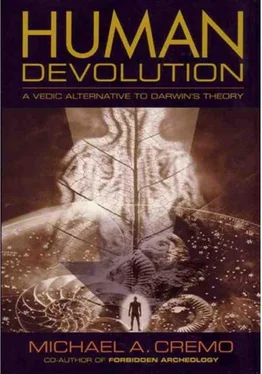Michael Cremo - Human Devolution - A Vedic Alternative To Darwin's Theory
Здесь есть возможность читать онлайн «Michael Cremo - Human Devolution - A Vedic Alternative To Darwin's Theory» весь текст электронной книги совершенно бесплатно (целиком полную версию без сокращений). В некоторых случаях можно слушать аудио, скачать через торрент в формате fb2 и присутствует краткое содержание. Год выпуска: 2003, ISBN: 2003, Издательство: Torchlight Publishing, Жанр: Старинная литература, на английском языке. Описание произведения, (предисловие) а так же отзывы посетителей доступны на портале библиотеки ЛибКат.
- Название:Human Devolution: A Vedic Alternative To Darwin's Theory
- Автор:
- Издательство:Torchlight Publishing
- Жанр:
- Год:2003
- ISBN:9780892133345
- Рейтинг книги:4 / 5. Голосов: 1
-
Избранное:Добавить в избранное
- Отзывы:
-
Ваша оценка:
- 80
- 1
- 2
- 3
- 4
- 5
Human Devolution: A Vedic Alternative To Darwin's Theory: краткое содержание, описание и аннотация
Предлагаем к чтению аннотацию, описание, краткое содержание или предисловие (зависит от того, что написал сам автор книги «Human Devolution: A Vedic Alternative To Darwin's Theory»). Если вы не нашли необходимую информацию о книге — напишите в комментариях, мы постараемся отыскать её.
Human Devolution: A Vedic Alternative To Darwin's Theory — читать онлайн бесплатно полную книгу (весь текст) целиком
Ниже представлен текст книги, разбитый по страницам. Система сохранения места последней прочитанной страницы, позволяет с удобством читать онлайн бесплатно книгу «Human Devolution: A Vedic Alternative To Darwin's Theory», без необходимости каждый раз заново искать на чём Вы остановились. Поставьте закладку, и сможете в любой момент перейти на страницу, на которой закончили чтение.
Интервал:
Закладка:
Wallace believed that certain physiological features of humans could not be explained by natural selection and survival of the fittest alone. He noted that the brains of primitive peoples were as large and developed as the brains of civilized peoples. It appeared, therefore, that the primitive people had brains with capacities far in excess of those demanded by their daily lives. Wallace said “natural selection could only have endowed the savage with a brain a little superior to that of an ape” (Wallace 1869; in Smith 1991, p. 32). Concerning the human hand, Wallace said the savage “has no need for so fine an instrument, and can no more fully utilise it than he could use without instruction a complete set of joiner’s tools” (Wallace 1869; in Smith 1991, p. 32). Wallace made similar arguments about the human capacity for speech. He took all of this as evidence that some intelligence had “guided the action” of the laws of evolutionary development “in definite directions and for special ends” (Wallace 1869; in Smith 1991, p. 33).
Wallace, as we have seen, believed the human race was of considerable antiquity. And interestingly enough, he thought that the current level of European civilization might not have been humankind’s highest moment. “And,” he added, “if we are thus led to believe that our present knowledge of nature is somewhat less complete than we have been accustomed to consider it, this is only what we might expect; for however great may have been the intellectual triumphs of the nineteenth century, we can hardly think so highly of its achievements as to imagine that, in somewhat less than twenty years, we have passed from complete ignorance to almost perfect knowledge on two such vast and complex subjects as the origin of species and the antiquity of man” (Wallace 1876; in Smith 1991, pp. 43–44). Although we must now talk of 150 years instead of twenty, what Wallace said towards the end of the nineteenth century remains true at the beginning of the twenty-first.
What is a Human Being? Matter, Mind, and Consciousness
The research of Sir Alfred Russel Wallace suggests that if we want to understand how human beings have come into existence, we should first of all understand what a human being is. Under the influence of materialistic assumptions about the nature of reality, most scientists have concluded that human beings are composed only of ordinary matter. This assumption limits the kinds of explanations we can offer for the origins of humanity. We are reduced to speculating about how ordinary matter organized itself into such a complex biological form. Even within this limited sphere, an exact explanation of the origin of the first life form and its subsequent development into the human form has thus far eluded science. This failure gives us the warrant to consider a different set of assumptions about the nature of the human organism, thus increasing our explanatory options.
When we consider all of the evidence available to science, we find ample justification for basing our study of human origins on the assumption that a human being, or any other living entity of our ordinary experience, is composed of not just one thing, ordinary matter, but of three things—matter, mind, and consciousness (or spirit). By mind, I mean a subtle material energy, connected with the human organism and capable of influencing ordinary matter or receiving sensory impressions in ways unexplained by the laws of science as currently accepted. Mind is not, however, conscious, although it may carry content for consciousness and may be in part instrumental for translating conscious intentions into action in the world of ordinary matter. By spirit I mean a conscious, experiencing, desiring, acting self that can exist apart from mind and matter. The assumption that humans, and other living things, are composed of matter, mind, and consciousness allows, indeed demands, new explanatory possibilities. We must explain from where these elements came, and how they combined in the human form.
Let us now review the scientific evidence favoring the assumption that a human being is composed not only of ordinary matter but also of the separate elements mind and consciousness. In the first part of this chapter, I shall include cases related to the existence of a mind element, and in the second part, I shall discuss evidence related to the existence of a conscious self apart from the subtle material mind and the gross physical body composed of ordinary matter.
PART ONE:
EVIDENCE FOR A MIND ELEMENT
In reviewing the evidence for a mind element, I have chosen to begin with contemporaries of Wallace and darwin. This is an arbitrary decision. Because I am addressing the question of darwinian evolution, which was formulated in the middle of the nineteenth century and developed to its mature form in the twentieth century, I thought it might be good to confine my citations of scientific evidence for a mind element to the same period of scientific development represented by darwinism.
James esdaile: mesmerism in india
James Esdaile was an English physician working in Bengal in the nineteenth century, when India was under British rule. He was a pioneer in using mesmerism, now called hypnosis, as an anesthetic. Patients who got painless operations regarded dr. Esdaile as “an incarnation of vishnu” (Esdaile 1852, p. 166). Around this time, however, ether and chloroform came into general use, and mesmerism was no longer quite so much needed as an anesthetic. Esdaile then turned his attention to the mysterious psychical effects he had encountered in his research into mesmerism. Esdaile (1852) reported that some of his entranced and blindfolded patients could identify objects and persons not visible to them by ordinary means. In addition to his own experiments, he also included in his book similar reports by other researchers.
for example, dr. chalmers, a calcutta surgeon, wanted to test the powers of a clairvoyant boy. In a room of his house, chalmers placed two candles on a table and a banknote between them. The banknote, which until the time of the experiment had been kept locked in a drawer, had not been seen by anyone except chalmers. In another room, the boy and some guests of chalmers were waiting. chalmers entered this room and asked the boy if he could see anything in any other room. The boy declared he saw two candles on a table. When asked if anything was between them, he said he saw a banknote. The boy then read accurately the four-figure serial number of the banknote and its value, twenty five rupees. dr. chalmers then returned to the room and secretly substituted a ten rupee note for the twenty-five rupee note. He told the boy he had turned the twenty five rupee note over, and asked what number he saw. The boy said he saw the number ten. chalmers returned to the room and placed a gold watch on the banknote. The boy accurately described it. Chalmers then secretly moved the watch and banknote to another room. While he was doing this, the boy announced to the guests who were with him, “He has lifted them from the table.” When chalmers came back to inform his guests of his action, he found they already knew of it (Esdaile 1852, pp. 76–78).
Esdaile possessed a remarkable ability to hypnotize people without their knowledge. for example, he described cases of silently hypnotizing blindfolded persons, inducing paralysis and insensibility in various limbs. Esdaile gave examples of entrancing unsuspecting subjects at a distance. Esdaile (1852, pp. 226–227) stated: “Mr. Grant, one of our oldest and most respected civil servants, and now in England, has often seen me entrance patients from another room while he was taking their portraits and engaging their attention as much as possible.”
Esdaile performed similar experiments with a blind man, thus ruling out any visual cues. Esdaile (1852, p. 227) reported: “I placed him on a stool without saying a word to him, and entranced him in ten minutes without touching him. I then roused him up a little, and made him a somnambulist; he walked with great difficulty, and, while doing so, said he was asleep and in his bed. He soon became unable to support himself, and fell into the trance again, in which he remained for two hours. This man became so susceptible, that by making him the object of my attention, I could entrance him in whatever occupation he was engaged, and at any distance within the hospital enclosure.”
Читать дальшеИнтервал:
Закладка:
Похожие книги на «Human Devolution: A Vedic Alternative To Darwin's Theory»
Представляем Вашему вниманию похожие книги на «Human Devolution: A Vedic Alternative To Darwin's Theory» списком для выбора. Мы отобрали схожую по названию и смыслу литературу в надежде предоставить читателям больше вариантов отыскать новые, интересные, ещё непрочитанные произведения.
Обсуждение, отзывы о книге «Human Devolution: A Vedic Alternative To Darwin's Theory» и просто собственные мнения читателей. Оставьте ваши комментарии, напишите, что Вы думаете о произведении, его смысле или главных героях. Укажите что конкретно понравилось, а что нет, и почему Вы так считаете.












